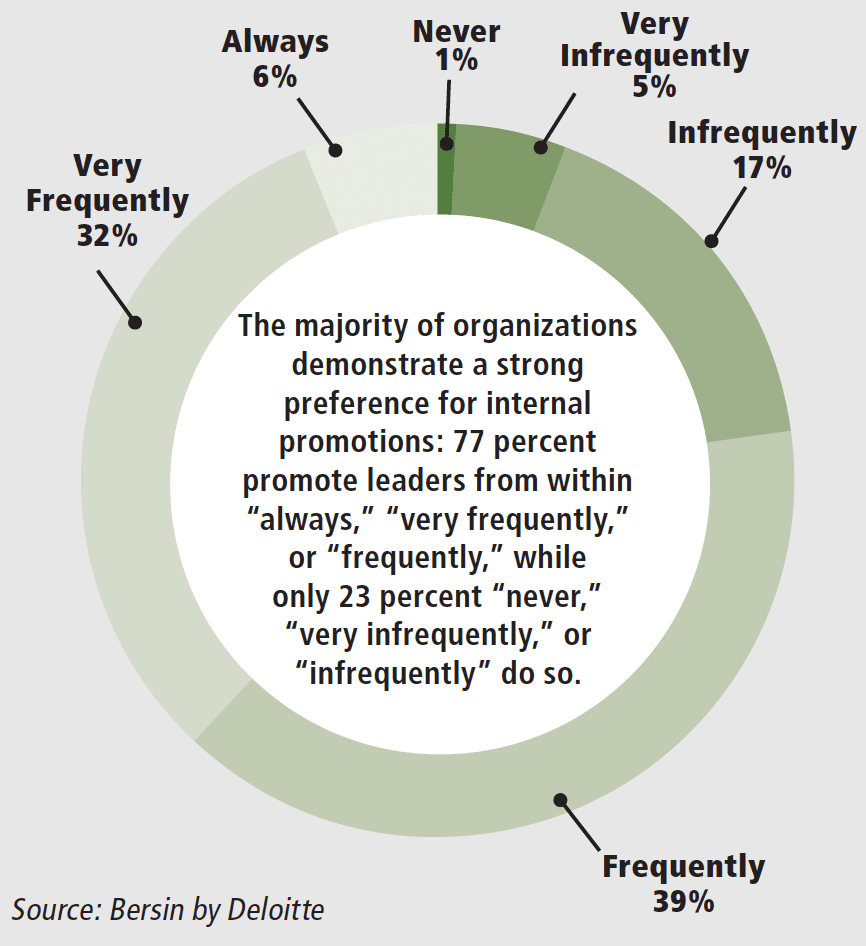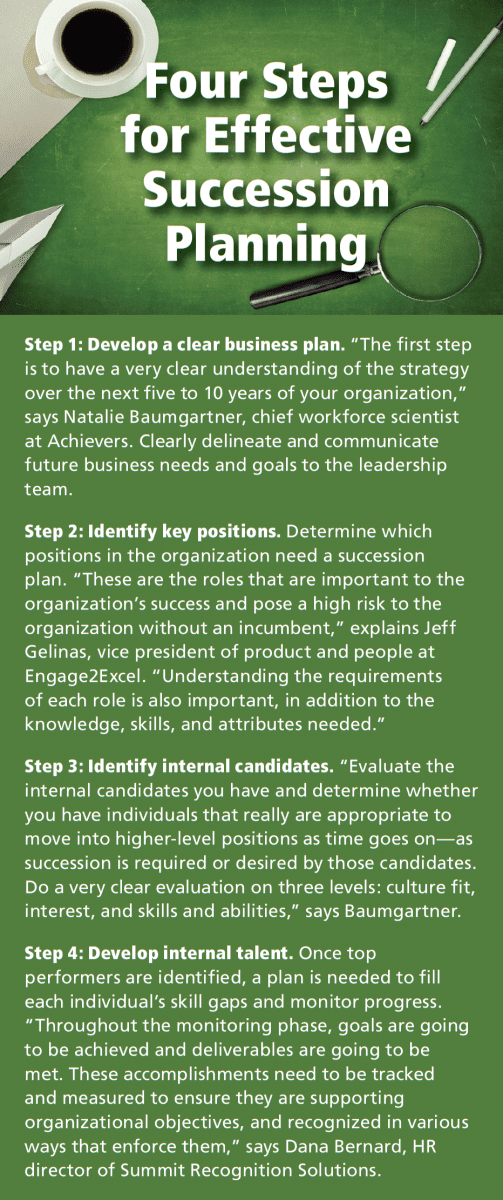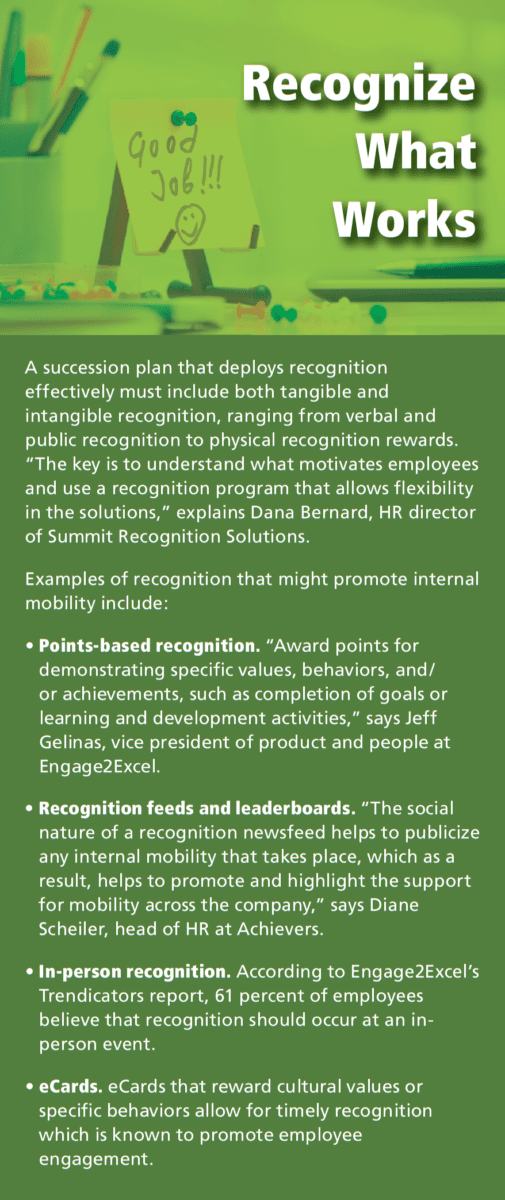Ways organizations can leverage their recognition programs to identify potential leaders and improve succession planning strategies.
By Marta Chmielowicz
There’s a saying among some HR professionals today: “The ‘war for talent’ is over -and talent won.” In the new world of work where growing employee expectations and improved workplace conditions are the norm, the job market has become less about employees competing for roles and more about organizations competing for employees.
According to Gallup’s 2017 State of the American Workplace report, 47 percent of the workforce says now is a good time to find a quality job, and more than half of employees (51 percent) are searching for new jobs or watching for openings. In addition, only 33 percent of employees are engaged in their roles -and of those who are actively disengaged, 73 percent are looking for other opportunities.
To effectively navigate today’s workplace climate, organizations should consider turning their focus inwards and building a viable and sustainable succession strategy that will help them meet business goals and take on the challenges of the future.
Looking Internally

Why? Internal mobility makes recruiting easier, faster, and less expensive. According to Gary Beckstrand, vice president of the O.C. Tanner Institute, “Promoting from within avoids costs associated with recruiting, training, and time spent to gain industry, business, and company knowledge.”
Promoting internally also provides opportunities for employees to learn, grow their skills, and progress in their careers, ultimately improving job satisfaction and engagement.
“Career growth is one of the seven key items that employees are seeking from their employer,” says Jeff Gelinas, vice president of product and people at Engage2Excel. “By hiring from within, you create new career opportunities for your existing staff and show your entire population that the organization is serious about recognizing and evolving the workforce.”
In addition to providing employee development opportunities, internal mobility also allows valuable employees to distribute their skills and expertise throughout the organization. “Internal hiring allows a company to shift proven talent between roles, building cross-functional strengths,” says HR Director of Summit Recognition Solutions Dana Bernard.
Leveraging Recognition for Internal Mobility

To do this effectively, organizations first need to define their long-term business goals, identify key positions and top performers, and implement development plans to fill skill gaps. Once an organization understands its talent needs, it can deploy recognition as a tool to encourage those behaviors.
“Recognition is really the most powerful lever we have in the world of employee engagement, and it’s also a critical tool to be used in succession planning because once we’ve identified what it is what we need to see from our internal employees, recognition can be used to encourage and support those behaviors,” says Natalie Baumgartner, chief workforce scientist at Achievers.
Managers are key in this process. “Managers know exactly what their direct reports need to work on to move up in the organization, and they can systematically focus on those goals and developmental objectives and use recognition as a tool to acknowledge when those things are happening,” explains Baumgartner.
The role of management is twofold: Managers are often the ones building development plans for employees and delivering the recognition. Offering managers the tools and training they need for effective talent development is essential for internal mobility.
“Organizations need to provide managers with the structure to help them develop their employees’ talent, while at the same time holding them accountable in terms of accomplishing this effectively,” says Bernard. “This should definitely be one of their individual performance goals, where they are rewarded and recognized when this goal is accomplished.”
Identifying Top Performers
But how can companies identify which employees are worth the investment?
The answer: data.
“Using a recognition platform allows you to track who is being recognized, how often, and for what. This is great data that complements performance reviews and other feedback mechanisms to evaluate performance, fit, and potential,” says Beckstrand.
While Weisgal believes that traditional performance-based indicators are important to use when identifying top talent, he agrees that recognition metrics add a valuable dimension to employee reviews, providing a fairer and more holistic view of overall performance.
By including recognition data in performance reviews, HR leaders can evaluate their employees’ potential as well as past performance. “Past performance is a good indicator of the ability to take on new or expanded responsibilities,” says Beckstrand. “A track record of receiving recognition for going above and beyond expectations is a strong indicator of a pattern of doing more than is expected, and a good sign of potential.”
However, it may be better to give then to receive. According to Baumgartner, individuals who frequently recognize those around them are even more likely to be promoted within an organization than individuals who frequently receive recognition. “When using a recognition tool or a recognition platform, organizations have a key piece of data into the likelihood that an individual is going to be a great candidate for promotion, and that’s the extent to which they recognize those around them,” she says.
By taking the time to observe and acknowledge great performance, these individuals demonstrate that they are invested in the success and development of the people around them as well as the organization as a whole.
Rewarding Desired Traits
Managers can use recognition to identify and reward individuals with key values that are aligned with their corporate culture. When a recognition program reinforces values such as integrity, leadership, or passion, employees are more likely to exhibit behaviors related to those values.

By identifying potential candidates early and providing consistent recognition and leadership training until a new opportunity becomes available, managers can ensure a quicker transition process.
“Not only is knowing who is well-suited for a future role important, the second part of that is developing those with leadership potential,” explains Bernard. “A company should identify the traits that they find critical to the success of a leader, or the leadership performance indicators. Those then become the basis on which an engagement and recognition strategy is built, and on which a company recognizes and rewards an individual’s success.”
The organization can also recognize its employees for participating in learning and development activities like online courses. “It’s important to send a message to the organization that taking steps to develop oneself is important to the organization’s success and leads to recognition moments,” says Gelinas.
Communicating Recognition Effectively
While an organization’s recognition platform is a powerful tool to strategically develop top performers, increase engagement, and improve corporate reputation, it must be communicated effectively for best results.
“Visibility of recognition achievements across an organization is the key thing -it’s critical. We live in the age of social networks so being able to share those moments and capture them becomes part of the communication strategy,” says Weisgal.
By publically recognizing employees who have changed roles or been promoted, Gelinas believes that organizations can increase the visibility of their internal mobility program, alerting employees to the available advancement opportunities and amplifying the employee experience.
“Meaningful and purposeful recognition communicates sincere appreciation of the employee’s contribution to the organization,” says Beckstrand. “It reinforces a culture not only of appreciation, but of opportunity and wellbeing. Promoting from within is consistent with a culture that values employees and recognizes their worth to take on expanded responsibilities and assume leadership positions.”














